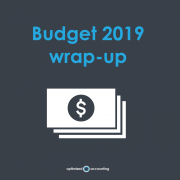Below is a summary of the key tax and superannuation changes that were announced in this years federal budget.
There are some wins for business – aimed to stimulate ‘Jobs & Growth’ which was this year’s slogan.
There are plenty of changes to superannuation – some good and some bad.
There was also an unfortunate extension to the indexation freeze of Medicare rebates. The government has proposed to extend the freeze until 2020 (that’ll be six years for those of you counting).
Whilst the government has canned the idea of a GP co-payment, it appears that over time these measures will force the hand of individual doctors and clinics to go to mixed or private billing just to maintain previous margins.
For our business and contractor clients, I look forward to meeting up with you to discuss the changes below as part of our pre 30 June tax planning meeting.
INDIVIDUALS / CONTRACTORS / TRUST BENEFICIARIES
Widening of the $80,000 tax bracket to $87,000 (From 1 July 2016)
Individuals with a personal taxable income of greater than $87,000 will now save an additional $315 per year in personal income tax.
Unincorporated Small Business Income Tax Offset (From 1 July 2016)
Sole traders, individual trust beneficiaries and contractors will be entitled to an 8% tax discount capped at $1,000 per year.
Temporary Budget Repair Levy (Expiring 30 June 2017)
The additional 2% that applies to high income earners on the portion of their taxable income which exceeds $180,000 has not been extended. This in effect brings the highest marginal tax rate down from 49% to 47%.
COMPANIES
Changes in the definition of a small business (1 July 2016)
The turnover threshold for defining a small business will change from $2 million to $10 million.
This will allow more businesses access to:
- The lower corporate tax rate.
- Simplified Depreciation.
- Simplified Trading Stock rules.
The current $2m turnover test will continue to apply for CGT concessions.
Reduction in corporate tax rate to 27.5% (From 1 July 2016)
Small companies (see above) will see the company tax rate reduced from 30% to 27.5%.
This tax saving will be extended to larger corporate groups with turnover of up to $25m in the 2017/18 financial year.
SUPERANNUATION
Low Income Superannuation Tax Offset (From 1 July 2017)
Taxpayers with an adjusted taxable income of less than $37,000 will receive a full rebate on the contributions tax paid for by their superannuation fund. Capped at $500 per year.
Low Income Spouse rebate – improved eligibility (From 1 July 2017)
The income threshold has increased to $37,000 (from $10,800) this allows a contributing spouse to receive up to $540 per year for making a superannuation contribution in to their low income spouses superannuation fund.
Additional 15% tax on super contributions for incomes > $250k (From 1 July 2017)
For taxpayers showing a taxable income of greater than $250k after adding back super contributions (currently $300k) the contributions tax has effectively doubled from 15% to 30%.
Reduction in the concessional superannuation contributions cap. (From 1 July 2017)
The concessional (tax-deductible) superannuation contributions cap will be reduced to $25,000 for all tax payers. Currently the cap sits at $30,000 for taxpayers under 50, and $35,000 for taxpayers over 50.
Personal superannuation contributions tax deductible for ALL individuals. (From 1 July 2017)
All individuals under 75 will be able to claim a tax-deduction for personal superannuation contributions. This is fantastic news for people who are partially self-employed and employees who would like to contribute more but are unable to do so through their employer.
Contribution Cap Rollover ‘catch up’ (From 1 July 2017)
Individuals with less than $500,000 in superannuation will be able to roll-over the unused portion of their contribution cap for up to five years. This will allow individuals to make larger tax-deductible superannuation contributions when they have the available cash to do so.
Introduction of the $1.6m superannuation transfer balance cap. (From 1 July 2017)
This limit will apply to individuals who hold more than $1.6m in super at retirement and moving to pension phase. This measure in effect limits the amount that can be drawn out tax-free. Additional superannuation balances will continue to have their earnings taxed in the fund at the standard superannuation tax rate of 15%.
It is important to note that tax-payers currently in pension phase will be required to reduce their balances come 1 July 2017.
Changes to Transition to Retirement TTR (From 1 July 2017)
The government will remove the tax-exemption for non-retired individuals who have assets supporting a TTR scheme. These earnings will be taxed at 15%.
Concessional Contribution Cap Rollover ‘catch up’ (From 1 July 2017)
Individuals with less than $500,000 in superannuation will be able to roll-over the unused portion of their concessional contribution cap for up to five years. This will allow individuals to make larger tax-deductible superannuation contributions when they have the available cash to do so.
Lifetime non-concessional contributions cap. (From 1 July 2007 yes, this one is retrospective)
The government has introduced a lifetime non-concessional contribution limit of $500,000.
This is a change from the previous arrangement which allowed up to $180,000 per year.
The lifetime cap will count all non-concessional contributions made from 1 July 2007 (the 2008 financial year). Individuals who have already exceeded the cap will be unable to make extra non-concessional contributions going forward.
If you would like to discuss anything from this article and how it may affect you, please do not hesitate to contact us.










